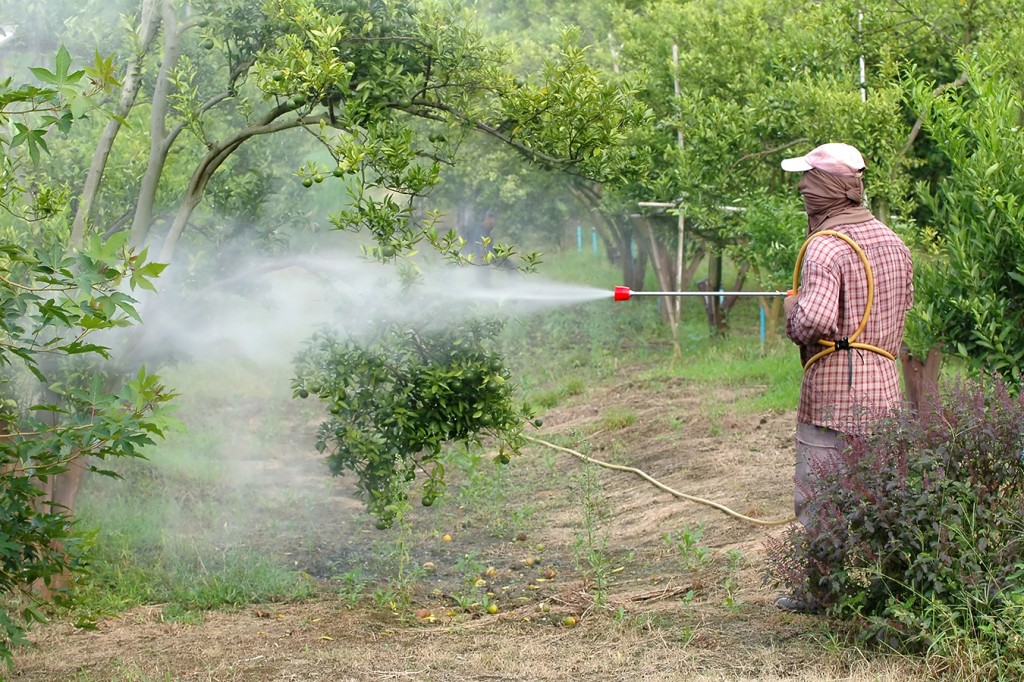
Farmer spray pesticide in orchard. Photo: iStock/Getty Images via California Healthline
California will ban the use of a widely used pesticide in the face of “mounting evidence” that it causes developmental problems in children, state officials announced Wednesday.
Several studies have linked prenatal exposure of chlorpyrifos to lower birth weights, lower IQs, attention deficit hyperactivity disorder and autism symptoms in children.
The chemical is mostly used on crops — including citrus, almonds and grapes — but is also applied on golf courses and in other non-agricultural settings.
The ban “is needed to prevent the significant harm this pesticide causes children, farm workers and vulnerable communities,” Jared Blumenfeld, secretary of the California Environmental Protection Agency (CalEPA), said in a statement.
California’s ban comes as federal regulators fight to keep the chemical on the market.
Almost two decades ago, the U.S. Environmental Protection Agency, which regulates pesticides at the federal level, prohibited the sale of chlorpyrifos for residential use.
But under the Trump administration, the agency rejected a proposal to ban its use altogether, ignoring the recommendations of its own scientists. It continues to defend the use of chlorpyrifos in court.
Some states aren’t waiting for the federal government to act, California Healthline reported last month. The New York legislature last week sent a proposed ban to Democratic Gov. Andrew Cuomo for consideration. A bill in the California legislature to ban chlorpyrifos was pending at the time of the CalEPA’s announcement. Oregon and Connecticut lawmakers also are considering bans.
Hawaii was the first state to enact a state ban last year.
“Because the science is pretty clear that this a dangerous chemical, it’s long past time to get it off the market,” said Virginia Ruiz, director of occupational and environmental health at the Washington, D.C.-based nonprofit Farmworker Justice. “There’s momentum now, and people and policymakers are becoming better educated about chlorpyrifos.”
Chlorpyrifos can be inhaled during application and as it drifts into nearby areas or ingested as residue on food. People also can be exposed through drinking water if their wells have been contaminated by it.
Globally, several companies make chlorpyrifos products. In the U.S., the most recognized brand names are Dursban and Lorsban, manufactured by Corteva Agriscience, formerly known as Dow AgroSciences.
Corteva Agriscience did not respond to requests for comment.
California citrus growers are among the groups that oppose the ban. They worry that eliminating chlorpyrifos could result in disease outbreaks among their fruit trees.
Casey Creamer, president of California Citrus Mutual, pointed to the Asian citrus psyllid, a tiny insect that feeds on citrus leaves that can transmit a disease known as Huanglongbing, or citrus greening, as one risk.
“The impacts are potentially significant,” he said. If farmers “don’t have the tools to effectively manage the psyllid, people are going to switch out or stop growing citrus.”
Implementing the ban in California could take up to two years as the state wades through the administrative process and tries to find safer options, CalEPA said in its announcement.
On Thursday, Democratic Gov. Gavin Newsom is expected to propose $5.7 million as part of his 2019-20 budget to support the transition to “safer, more sustainable alternatives,” the announcement said.
The agency added that its decision to ban chlorpyrifos “follows mounting evidence … that the pesticide causes serious health effects in children and other sensitive populations,” even at low levels of exposure.
The California Farm Bureau Federation warned that food may get pricier as a result of the ban, leaving state residents more dependent on produce grown in states with less stringent regulations.
“Protecting our food supply, rural economy and the many jobs that depend on California agriculture will require state agencies to be open-minded and realistic in evaluating ways to fight pests and plant diseases,” said Jamie Johansson, the federation’s president.
Ana B. Ibarra: aibarra@kff.org, @ab_ibarra













